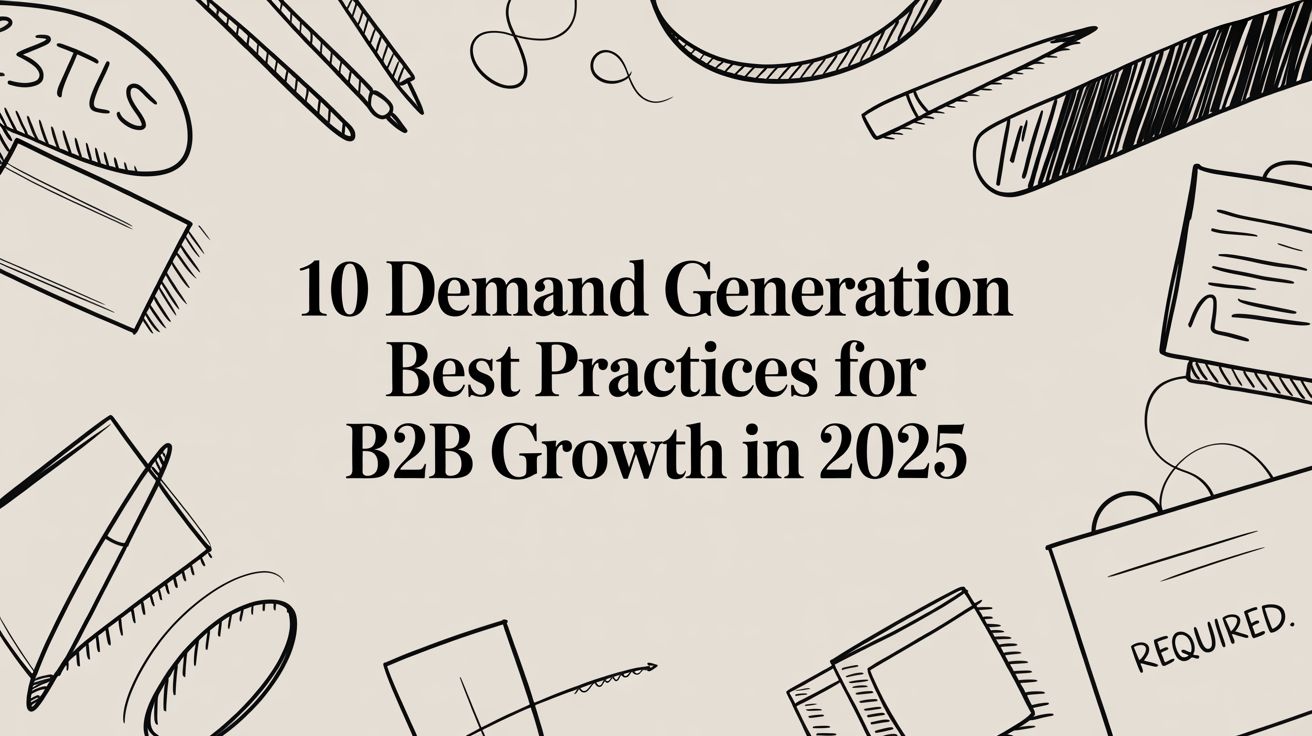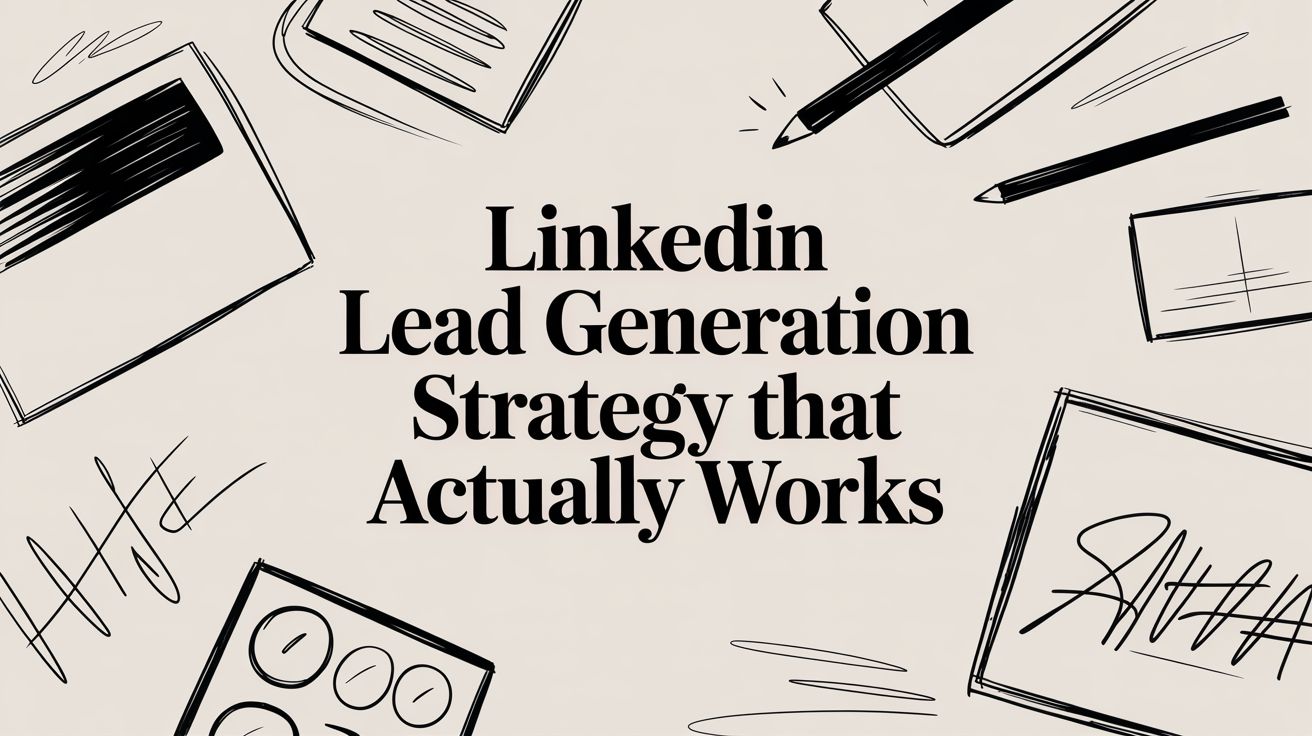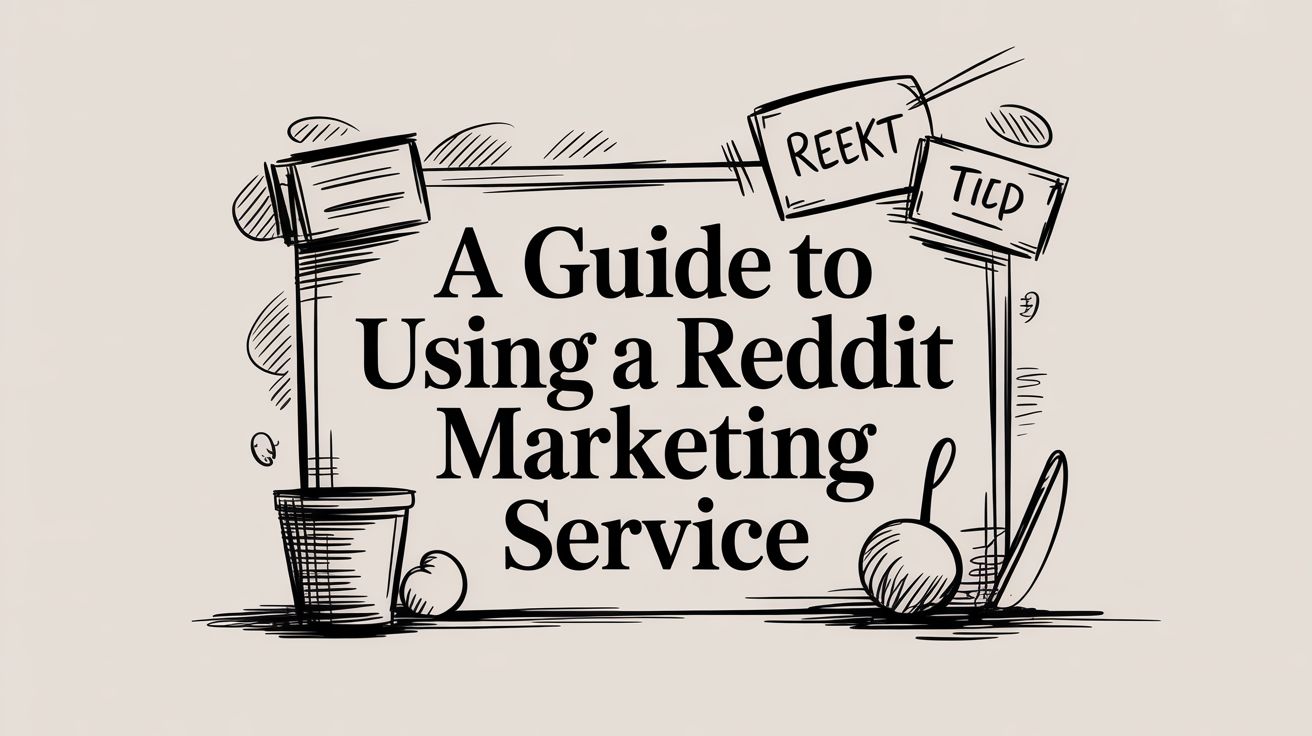In the crowded B2B landscape, the old playbook of chasing leads and filling funnels is no longer enough. Sustainable growth requires a fundamental shift from lead generation to demand generation: a strategic approach focused on creating authentic desire for your product long before a prospect even considers a purchase. This means building brand awareness, establishing trust, and educating your target audience so that when they are ready to buy, your solution is the only one that comes to mind.
This comprehensive guide breaks down the 10 essential demand generation best practices that modern B2B SaaS teams are using to create predictable pipeline and build a brand that buyers actively seek out. We're moving past generic advice to deliver actionable strategies that resonate with savvy founders, growth leads, and marketing teams. To truly leverage modern demand generation as your ultimate growth engine, delve into these powerful website marketing strategies for SaaS & Startups. This listicle, however, focuses on the broader strategic pillars that fuel that engine.
From leveraging intent data and orchestrating multi-channel campaigns to mastering authentic community engagement, these strategies will equip you to not just capture existing demand, but to create it from the ground up. You will learn how to implement account-based marketing, build thought leadership through content, and utilize customer data platforms for a more personalized approach. Each practice is designed to be a practical, scalable component of a robust growth framework, helping you build a brand that doesn't just compete, but commands attention in your market.
1. Account-Based Marketing (ABM)
Account-Based Marketing (ABM) flips the traditional demand generation funnel on its head. Instead of casting a wide net to capture as many leads as possible, ABM is a strategic, focused approach where marketing and sales teams work together to target a specific set of high-value accounts. It treats each target company as a unique market, delivering hyper-personalized messaging and content to key decision-makers within that organization.
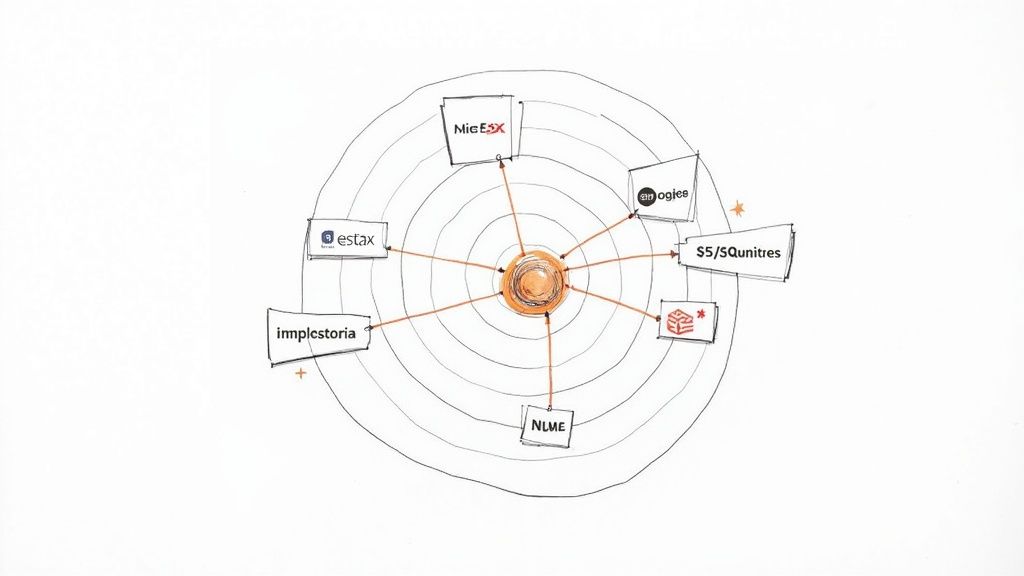
This method is one of the most effective demand generation best practices for B2B companies with a high average contract value (ACV). By concentrating resources on accounts with the highest revenue potential, teams can increase deal size, accelerate the sales cycle, and improve marketing ROI. Companies like Salesforce and Microsoft have successfully used ABM to engage and win major enterprise customers.
How to Implement an ABM Strategy
Getting started with ABM requires tight alignment and a methodical approach. It’s not just a marketing campaign; it's a fundamental shift in how you approach your go-to-market strategy.
- Identify and Prioritize High-Value Accounts: Work with sales to create an Ideal Customer Profile (ICP). Use firmographic data (industry, company size, revenue) and intent data from platforms like 6sense to identify accounts actively researching solutions like yours.
- Map Key Stakeholders: For each target account, identify the buying committee. This includes champions, influencers, decision-makers, and blockers. Create detailed personas for each role to understand their specific pain points and motivations.
- Create Personalized Content: Develop content that speaks directly to the challenges of the target account and its key stakeholders. This could include industry-specific case studies, personalized webinar invitations, or custom-tailored reports.
- Execute Coordinated, Multi-Channel Campaigns: Deploy your personalized content across all relevant channels simultaneously. This includes targeted ads on LinkedIn, personalized email sequences, and direct mail. For a deeper dive into channel-specific tactics, explore this detailed guide to LinkedIn lead generation strategy.
- Measure and Optimize: Track ABM-specific metrics such as account engagement, pipeline velocity, win rate, and average deal size. Use these insights to refine your targeting and messaging for future campaigns.
2. Content Marketing and Thought Leadership
Content Marketing and Thought Leadership focus on creating and distributing valuable, relevant, and consistent content to attract and retain a clearly defined audience. Instead of directly pitching products or services, this approach establishes your brand as a credible authority, building trust and guiding prospects through their buying journey organically. It’s about solving your audience's problems and answering their questions.
This strategy is a cornerstone of modern demand generation best practices, particularly for B2B and SaaS companies aiming to generate inbound leads. By positioning company leaders and the brand itself as industry experts, you attract high-intent prospects through organic search, social media, and referrals. Companies like HubSpot have built empires on this model, using their blog and educational resources to attract millions of visitors and convert them into customers.
How to Implement a Content and Thought Leadership Strategy
A successful content strategy requires a deep understanding of your audience and a commitment to providing genuine value. It's a long-term play that builds a powerful, sustainable engine for growth.
- Align Content with the Buyer's Journey: Map out your customer's path from awareness to decision. Create top-of-funnel content (blogs, social posts) to attract, mid-funnel content (webinars, whitepapers) to educate, and bottom-of-funnel content (case studies, demos) to convert.
- Conduct In-Depth Keyword Research: Use tools like Ahrefs or Semrush to identify high-intent keywords your ideal customers are searching for. Focus on long-tail keywords that signal a specific problem you can solve.
- Establish a Consistent Publishing Cadence: Consistency is key to building an audience and satisfying search engine algorithms. Aim to publish new, high-quality content on a regular schedule, whether it's weekly or bi-weekly.
- Repurpose Content for Maximum Reach: Don’t let great content die after one post. Turn a webinar into a blog post, a series of blog posts into an ebook, and key data points into social media graphics. This maximizes the ROI of your content creation efforts.
- Focus on Solving Prospect Problems: The most effective content is relentlessly helpful. Before creating any piece, ask: "What specific problem does this solve for my target audience?" Use original data, research, and unique insights to support your claims and stand out.
3. Intent Data and Predictive Analytics
Intent Data and Predictive Analytics provide a powerful lens into which prospects are actively in-market for your solution before they ever fill out a form. Instead of waiting for leads to come to you, this approach uses behavioral signals from across the web to identify and prioritize accounts that are demonstrating purchase intent right now. This is one of the most proactive demand generation best practices for modern B2B teams.
This strategy allows you to focus resources on buyers who are already in the evaluation phase, dramatically improving efficiency and shortening sales cycles. Platforms like 6sense and Demandbase use AI to analyze billions of online events, such as content consumption, keyword searches, and competitor website visits, to surface high-propensity accounts. This data-driven approach transforms marketing from a reactive function into a predictive engine for revenue.
How to Implement Intent Data and Predictive Analytics
Leveraging intent data requires a systematic approach to turn raw signals into actionable sales and marketing plays. It's about finding the right prospects at the perfect moment.
- Define Your Intent Topics: Start by identifying the keywords, competitors, and topics that signal a buyer is researching your solution category. Align these topics with your core value propositions and product features.
- Integrate Data Sources: Combine third-party intent data from providers like Bombora or ZoomInfo with your first-party data (website visits, CRM activity). This creates a holistic view of an account's interest level and engagement.
- Create a Predictive Scoring Model: Use firmographic, technographic, and intent data to build a model that scores and ranks accounts based on their likelihood to buy. This ensures sales and marketing prioritize the same top-tier accounts.
- Trigger Timely, Relevant Outreach: Use intent signals to activate specific marketing and sales plays. For example, if an account is researching a competitor, trigger a targeted ad campaign highlighting your key differentiators and have sales follow up with a relevant email.
- Measure and Refine: Track metrics like pipeline created from intent-qualified accounts, conversion rates, and deal velocity. Regularly review and adjust your intent topics and scoring model to optimize performance and adapt to market changes.
4. Multi-Channel Campaign Orchestration
Multi-Channel Campaign Orchestration involves coordinating integrated marketing efforts across various platforms to deliver a unified, consistent message. Instead of treating channels like email, social media, paid ads, and events as separate silos, this approach weaves them together. This ensures prospects receive a seamless and coherent experience as they move through the buyer's journey, encountering your brand at multiple, strategic touchpoints.
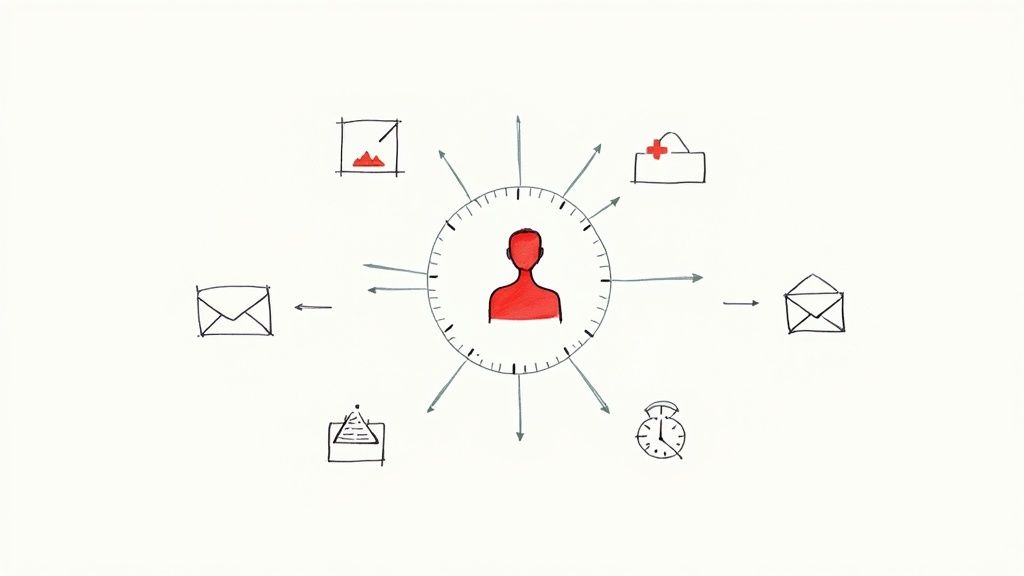
This strategy is one of the most powerful demand generation best practices because it mirrors how modern B2B buyers actually research and make decisions. By being present and consistent across the channels your audience uses, you build brand recognition, reinforce key messages, and significantly increase the likelihood of conversion. Marketing automation platforms like HubSpot and Marketo are built to execute these sophisticated, multi-layered campaigns at scale.
How to Implement Multi-Channel Campaign Orchestration
A successful multi-channel strategy requires careful planning, automation, and consistent analysis to ensure all moving parts work in harmony.
- Map the Customer Journey: Before launching, identify the key stages in your customer's journey. Determine which channels are most effective at each stage, from initial awareness (e.g., social media ads) to consideration (e.g., webinars, email nurture) and decision (e.g., case studies, sales outreach).
- Establish a Single Customer View: Use a CRM or CDP to consolidate data from all channels. This unified view allows you to track every touchpoint and understand how different interactions influence a prospect's path to purchase.
- Create Consistent Messaging and Creative: Develop a core campaign message and a set of creative assets (visuals, copy, CTAs) that are adapted for each channel. The look and feel should be consistent, but the format should be native to the platform.
- Use Marketing Automation: Leverage automation tools to trigger actions across channels based on user behavior. For example, a website visitor who downloads an ebook could automatically be added to a targeted email nurture sequence and a LinkedIn Custom Audience for retargeting. If you're looking to enhance your outreach, find out how to generate leads with social media.
- Track and Optimize Your Channel Mix: Use UTM parameters and attribution modeling to measure the performance of each channel. Analyze the data to understand which channels drive the most engagement and conversions, and reallocate your budget and resources accordingly.
5. Strategic Partnerships and Co-Marketing
Strategic partnerships and co-marketing involve collaborating with complementary companies to tap into new, relevant audiences. Instead of building an audience from scratch, you leverage the trust and reach of an established partner whose customers fit your ideal customer profile. This approach amplifies brand visibility and generates high-quality leads through shared resources and credibility.
This method is one of the most powerful demand generation best practices for B2B SaaS companies looking to scale efficiently. By aligning with non-competing technology partners or industry influencers, you create a powerful joint value proposition that benefits both audiences. Successful examples include HubSpot’s integration partnerships with companies like Salesforce, or the AWS Partner Network, which runs extensive co-marketing programs.
How to Implement a Co-Marketing Strategy
A successful partnership requires more than just a handshake; it needs a clear strategy, defined goals, and ongoing communication to deliver results for both parties.
- Identify and Vet Potential Partners: Look for companies that share a similar target audience but offer a non-competing, complementary solution. Analyze their market reputation, audience engagement, and company values to ensure strong alignment.
- Define a Joint Value Proposition: Clearly articulate why the partnership benefits the end customer. How do your products or services work together to solve a bigger problem? This message will be the foundation of all co-marketing campaigns.
- Establish Clear Goals and Responsibilities: Before launching any initiative, agree on key performance indicators (KPIs) like leads generated, pipeline created, or trial sign-ups. Document who is responsible for content creation, promotion, lead management, and reporting.
- Execute Joint Campaigns: Collaborate on high-value content and events. This could include co-hosted webinars, joint research reports, integrated case studies, or sponsoring an industry event together. Ensure both brands are prominently featured.
- Track and Attribute Success: Implement a system for sharing and tracking leads from co-marketing activities. Use dedicated landing pages, UTM parameters, and CRM fields to accurately measure the pipeline and revenue generated from each partnership.
6. Events and Experiential Marketing
Events and experiential marketing create memorable, interactive experiences that directly engage prospects and customers. Whether in-person or virtual, tactics like conferences, webinars, and exclusive roundtables move beyond passive content consumption, allowing you to build authentic relationships, capture high-intent leads, and create a strong sense of community around your brand.
This hands-on approach is one of the most powerful demand generation best practices because it provides a platform for direct, two-way communication. It helps humanize your brand and accelerate the buyer's journey by addressing specific questions and showcasing value in a dynamic environment. Major industry events like Salesforce's Dreamforce or HubSpot's INBOUND conference demonstrate the massive scale and impact these experiences can have on pipeline and brand loyalty.
How to Implement an Events Strategy
A successful event is more than just a presentation; it's a carefully orchestrated experience designed to meet specific business objectives. A strategic approach ensures your investment translates into measurable results.
- Define Clear Objectives: Before planning, determine your primary goal. Are you aiming for a high volume of new leads, engaging a specific list of target accounts, or increasing brand awareness in a new market? Your objective will dictate the format, content, and promotion of the event.
- Create Multiple Engagement Touchpoints: Design the experience to keep attendees involved. For a webinar, use live polls, Q&A sessions, and breakout rooms. At a trade show, create an interactive booth demo, host a networking happy hour, or schedule 1-on-1 meetings.
- Enable Your Sales Team: Equip your sales team with event-specific talking points, attendee lists, and dedicated collateral. Brief them on key sessions and potential high-value prospects to ensure they can have relevant, informed conversations.
- Develop a Post-Event Nurture Plan: The follow-up is critical. Segment attendees based on their engagement level (e.g., asked a question, attended a demo) and enroll them in immediate, personalized nurture sequences. Reference their event experience to make the outreach more relevant.
- Measure and Analyze Performance: Track metrics beyond just registration numbers. Analyze attendance rates, audience engagement scores, qualified leads generated, meetings booked, and ultimately, pipeline influence and ROI to prove the event's value.
7. Customer Data Platforms (CDP) and First-Party Data Strategy
A Customer Data Platform (CDP) is a centralized system that gathers and unifies customer data from all sources to build a single, coherent view of each customer. As third-party cookies are phased out, a robust first-party data strategy, powered by a CDP, is no longer optional; it is essential for modern demand generation. This approach involves collecting data directly from your audience through website interactions, product usage, email engagement, and customer support channels.
This strategy is one of the most critical demand generation best practices for creating deeply personalized and relevant marketing campaigns. By consolidating data, you can understand customer behavior, predict needs, and deliver tailored experiences that build trust and drive conversions. Companies like Segment and Tealium provide the infrastructure for businesses to harness their first-party data, turning raw information into actionable marketing intelligence.
How to Implement a CDP and First-Party Data Strategy
Building a first-party data asset requires a strategic approach to data collection, governance, and activation. It’s a foundational investment that pays dividends across your entire go-to-market motion.
- Audit Data Sources and Establish Governance: Begin by mapping all your existing customer data touchpoints (CRM, analytics, support desk). Establish clear data governance and privacy protocols to ensure compliance with regulations like GDPR and CCPA, and implement proper consent management from the start.
- Prioritize First-Party Data Collection: Actively create opportunities to gather data directly. This includes using interactive content like quizzes, offering gated resources, running surveys, and implementing clear newsletter sign-up forms. Every interaction is a chance to enrich customer profiles.
- Select and Implement a CDP: Choose a CDP that integrates with your existing tech stack, such as Adobe Real-Time CDP or Salesforce Customer Data Platform. Start with a few key use cases, like building a specific audience segment for a targeted campaign, before rolling out a full implementation.
- Enable Marketing and Sales Teams: Use the CDP to build detailed customer segments based on behavior, purchase history, and engagement levels. Equip your teams with these insights to personalize outreach, create targeted ad campaigns, and improve lead nurturing sequences.
- Measure and Monitor: Create dashboards to track the quality and growth of your first-party data. Monitor key metrics related to audience segmentation, campaign personalization effectiveness, and the overall impact on pipeline creation and revenue.
8. Video Marketing and Visual Content
In a crowded digital landscape, video and visual content cut through the noise to capture attention and convey complex ideas quickly. This approach leverages engaging formats like videos, infographics, and interactive visuals to educate, entertain, and convert prospects. Visuals are processed faster by the brain than text, making them a powerful tool for explaining product features and building brand personality.

This method is one of the most versatile demand generation best practices because it works across the entire customer journey, from top-of-funnel brand awareness to bottom-of-funnel product demos. Companies like Wistia and Loom have built their entire brands around the power of video for business. Similarly, Slack's animated product demonstrations make its platform feel intuitive and accessible, while viral launch videos like Dollar Shave Club’s prove that creativity can generate massive demand with a modest budget.
How to Implement a Video Marketing Strategy
Integrating video doesn't require a Hollywood-level production budget. Authenticity and value are often more important than high-gloss polish, especially in B2B.
- Start with Simple, High-Value Videos: Use tools like Loom to create quick, authentic screen recordings for sales outreach or customer support. Create short-form videos for social platforms like LinkedIn and TikTok to share insights and build a following.
- Keep Content Concise and Focused: For social media, aim for videos under two minutes. For more in-depth educational content like webinars or tutorials on YouTube, longer formats are acceptable, but the value must be clear from the start.
- Include a Clear Call-to-Action (CTA): Every video should guide the viewer to the next step. Use clickable end screens on YouTube, add links in video descriptions, or verbally direct viewers to visit your website or book a demo.
- Optimize for Search and Accessibility: Write keyword-rich titles and descriptions to improve discoverability on platforms like YouTube. Always include captions to make your content accessible to a wider audience and those watching without sound.
- Repurpose and Distribute Widely: A single webinar can be repurposed into dozens of assets. Create short clips for social media, a blog post with the embedded video, and an infographic summarizing the key takeaways to maximize your reach.
9. Marketing Automation and Lead Nurturing
Marketing automation and lead nurturing are the engines that power scalable demand generation. This practice involves using software to automate repetitive marketing tasks and deliver personalized, timely communication to guide prospects through the buyer's journey. Instead of manual follow-ups, automation triggers actions based on a prospect's behavior, engagement level, and interests, ensuring no lead falls through the cracks.
This approach is one of the most fundamental demand generation best practices because it enables teams to build relationships with a large audience without sacrificing personalization. It systematically moves leads from awareness to consideration, warming them up for a sales conversation. Platforms like HubSpot, Marketo, and ActiveCampaign are pioneers in this space, providing the tools to create sophisticated nurturing workflows that convert interest into revenue.
How to Implement Marketing Automation and Lead Nurturing
Effective automation isn't just about sending emails; it's about delivering the right message to the right person at the right time. A strategic approach is essential for success.
- Map the Buyer's Journey: Before building any workflow, outline the key stages a prospect goes through, from initial awareness to the point of purchase. Identify the questions they have at each stage and the content that will answer them.
- Segment Your Audience: Group your contacts based on specific criteria like job title, industry, company size, or website behavior. Proper segmentation is the foundation for delivering relevant and personalized messaging that resonates.
- Build Foundational Nurturing Workflows: Start with a simple welcome series for new subscribers or a lead nurturing sequence for prospects who download a resource. These workflows should provide value and gently introduce your solution.
- Personalize Content at Scale: Use dynamic content and personalization tokens (like name, company, or job title) to make automated communications feel one-to-one. This small touch significantly boosts engagement rates.
- Measure and Optimize Performance: Regularly review key metrics for your workflows, such as open rates, click-through rates, and conversion rates. Monitor unsubscribe rates to ensure your messaging isn't fatiguing your audience, and A/B test elements like subject lines and calls-to-action to continuously improve results.
10. SEO and Organic Search Optimization
Search Engine Optimization (SEO) is the foundational practice of improving your website's visibility on search engines like Google. Instead of paying for clicks, SEO focuses on earning organic traffic by creating high-quality, relevant content that directly answers the questions of your target audience. It’s a long-term strategy that builds a sustainable, high-intent lead pipeline.
This method is one of the most powerful demand generation best practices because it captures users at the precise moment they are actively searching for solutions. To fully grasp the mechanics of modern demand generation, it's essential to first understand what Search Engine Optimization (SEO) entails. Companies like HubSpot and Semrush have built marketing empires by consistently ranking for high-value keywords, attracting millions of qualified visitors each month.
How to Implement an SEO Strategy
A successful SEO strategy involves a multi-faceted approach that combines technical optimization, content creation, and authority building. It requires patience and consistent effort to see meaningful results.
- Conduct In-Depth Keyword Research: Use tools like Ahrefs or Semrush to identify the terms and phrases your Ideal Customer Profile (ICP) uses when searching for solutions. Focus on keywords with high purchase intent and realistic difficulty.
- Create High-Value, Topic-Cluster Content: Develop comprehensive content that addresses your target keywords and related subtopics. Organize content into topic clusters, with a central "pillar page" on a broad topic linking out to more detailed "cluster pages" on specific sub-topics.
- Optimize On-Page Elements: Ensure every page is optimized with clear title tags, compelling meta descriptions, and structured headers (H1, H2, H3). Optimize images and build a logical internal linking structure to help search engines understand your site's hierarchy.
- Build Authority with Backlinks: Earn high-quality backlinks from reputable websites in your industry. This can be achieved through guest posting, digital PR, and creating link-worthy content that others want to cite.
- Ensure Technical Excellence: Your website must be technically sound. Focus on improving page speed, ensuring mobile-friendliness, and using structured data (schema markup) to help search engines better understand your content. For a deeper look at driving this type of growth, discover how to increase website traffic organically.
Top 10 Demand Generation Practices Comparison
| Strategy | 🔄 Implementation Complexity | ⚡ Resource Requirements & Speed | 💡 Ideal Use Cases | ⭐ Expected Outcomes (Quality) | 📊 Measurable Impact |
|---|---|---|---|---|---|
| Account-Based Marketing (ABM) | High — needs deep account research, sales/marketing alignment | High resources, significant upfront investment, slower to scale | Enterprise B2B, high-value accounts, expansion/renewals | Very high conversion and deal size uplift | Account-level ROI, pipeline growth, win rates |
| Content Marketing & Thought Leadership | Medium — ongoing planning and content ops | Moderate resources, slow-to-mature (3–6+ months) | Brand building, inbound lead generation, authority positioning | High long-term authority and trust | Organic traffic, engagement, lead volume over time |
| Intent Data & Predictive Analytics | Medium–High — data integration and modeling required | High cost platforms but fast signal detection | Prioritizing outreach, timing engagement, account prioritization | High accuracy for timing and prioritization | Conversion uplift, reduced time-to-engage, scoring lift |
| Multi-Channel Campaign Orchestration | High — complex tech stack and coordination | High resources; enables rapid reach when executed | Product launches, cross-channel nurturing, omnichannel experiences | Increased engagement and improved customer experience | Cross-channel conversions, attribution clarity, touchpoint metrics |
| Strategic Partnerships & Co‑Marketing | Medium — partner selection and contractual setup | Moderate resources; accelerates reach via partners | Market expansion, complementary offerings, joint GTM | Good reach and credibility when aligned | Partner-sourced leads, joint campaign ROI, referral rates |
| Events & Experiential Marketing | Medium–High — logistics, production and staffing | High cost and time; immediate high-touch engagement | Product demos, relationship building, high-touch sales cycles | High-quality leads and stronger relationships | Attendance, engagement, pipeline influence, demo-to-deal rates |
| CDP & First‑Party Data Strategy | High — technical implementation and governance | High investment, long-term payoff; ongoing maintenance | Personalization at scale, privacy-first targeting, cookie deprecation | High personalization accuracy and future-proofing | Improved targeting, retention, LTV, consented audiences |
| Video Marketing & Visual Content | Medium — production skill varies by scope | Moderate–High production costs; quick engagement lift | Product demos, testimonials, social short-form, education | Very high engagement and information retention | Views, watch time, social shares, conversion rates |
| Marketing Automation & Lead Nurturing | Medium — setup of workflows and scoring | Moderate resources; speeds follow-up and scaling | Scalable lead nurturing, behavior-driven email programs | Improved conversion rates and qualification efficiency | Conversion uplift, time-to-close reduction, email metrics |
| SEO & Organic Search Optimization | Medium — technical and content discipline ongoing | Low ongoing ad spend, slower to produce results (6–12+ months) | Sustainable inbound acquisition, content-driven growth | High long-term qualified traffic and credibility | Organic traffic, rankings, leads, inbound conversion rates |
Putting It All Together: From Best Practices to Business Impact
Navigating the landscape of modern demand generation can feel like assembling a complex puzzle. We've explored a comprehensive array of powerful strategies, from the surgical precision of Account-Based Marketing (ABM) to the broad, foundational reach of SEO and content marketing. The journey through these ten demand generation best practices isn't about adopting every tactic overnight. Instead, it’s about strategic selection and masterful integration.
The true art of demand generation lies in creating a cohesive, self-reinforcing system. Your content marketing efforts fuel your SEO, which in turn captures intent. That intent data then informs your ABM campaigns and your multi-channel orchestration. Each practice is a gear in a larger machine, working together to not just capture existing interest, but to actively create new demand for your solution in the market.
From Theory to Tangible Results
The shift from a lead-centric to a demand-centric model is a profound one. It requires a deep understanding of your ideal customer, a commitment to delivering genuine value, and the patience to build long-term relationships. Chasing vanity metrics like lead volume is a short-term game. Building a brand that people trust, seek out, and advocate for is how you win in the long run.
The core theme connecting all these practices is customer-centricity. Whether you are leveraging a Customer Data Platform to personalize outreach or using video to tell authentic stories, the goal is the same: to meet your audience where they are with the value they need, exactly when they need it. This approach transforms marketing from an interruption into a welcome conversation.
Key Takeaway: Sustainable growth isn't born from isolated tactics. It's the result of an integrated strategy where content, data, and channel execution work in harmony to build brand equity and create genuine customer desire.
Your Actionable Path Forward
Feeling overwhelmed by the possibilities is natural. The key is to start small, gain momentum, and build from there. Don't try to boil the ocean. Instead, use this simple framework to get started:
Audit & Assess: Begin by evaluating your current marketing efforts against the practices discussed. Where are your biggest gaps? Where do you have foundational strengths to build upon? A simple SWOT (Strengths, Weaknesses, Opportunities, Threats) analysis can be incredibly revealing here.
Prioritize for Impact: Select just one or two best practices that align most directly with your immediate business goals and available resources. If you have a strong product but low visibility, SEO and Content Marketing might be your priority. If you're targeting a handful of high-value enterprise accounts, a focused ABM pilot program makes more sense.
Execute & Measure: Commit fully to your chosen initiatives. Define clear, measurable KPIs before you start. Are you tracking pipeline velocity, customer acquisition cost (CAC), or brand search volume? Relentlessly track your progress, learn from the data, and don't be afraid to iterate on your approach.
Mastering these demand generation best practices is more than a marketing objective; it's a fundamental business driver. It’s the engine that creates a predictable revenue pipeline, fosters unshakeable customer loyalty, and builds a resilient brand that can weather any market condition. By shifting your focus from simply harvesting low-hanging fruit to cultivating a fertile orchard, you're not just playing the game-you're changing it.
Ready to master authentic engagement on social platforms like X (Twitter), Reddit, and LinkedIn? Scaling genuine, community-driven outreach is one of the most powerful demand generation best practices, and Replymer is the AI-powered tool built to help you do it efficiently. Stop missing conversations and start building your brand with Replymer.
